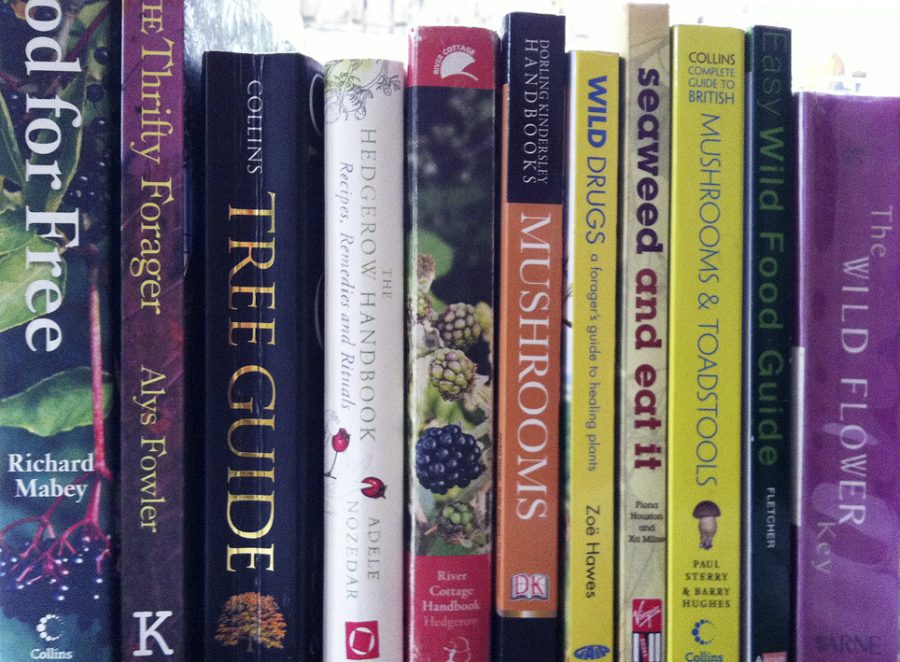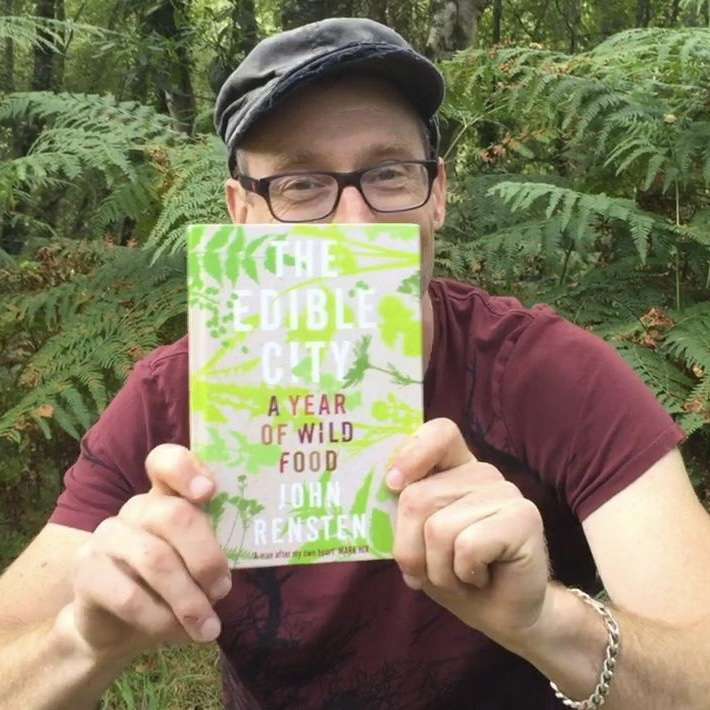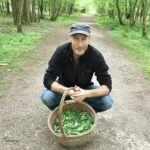 The snow has gone and if your happy to brave a bit of cold, wet weather there are plenty of amazing winter greens out there just begging to be picked (see my January posting for many of these). Having said that, I have wanted to write about a few of my favorite foraging books for while and this is a good time of year to cosy up indoors, practice a few culinary skills and do a bit of research for the coming months. It’s very rewarding to come across a new wild food only previously seen in a book and be able to ID it on site or to find some tasty treat with a great recipe already in mind. There is absolutely no substitute for being outdoors and getting immersed in nature but backing up your knowledge with a bit of reading is invaluable; providing you have the right books and don’t waste time wading through anything poorly written, inaccurate or just plain boring. I did not do well at school (tiny violins begin to wail) but despite being told my window for learning was well and truly shut, I find that reading about something, hunting for it, finding it, observing it change with the seasons, cooking or preserving it and then eating it, is an excellent way to learn without any of the academic drudgery I remember from my teens. Below ( and in no specific order) are a few of the books I repeatedly return to and I wholeheartedly recommend every forager, experienced or otherwise, have on their shelf. It’s not definitive by any means and part of the fun is finding the books you get on with so please take or ignore my suggestions as you wish. Happy swotting.
The snow has gone and if your happy to brave a bit of cold, wet weather there are plenty of amazing winter greens out there just begging to be picked (see my January posting for many of these). Having said that, I have wanted to write about a few of my favorite foraging books for while and this is a good time of year to cosy up indoors, practice a few culinary skills and do a bit of research for the coming months. It’s very rewarding to come across a new wild food only previously seen in a book and be able to ID it on site or to find some tasty treat with a great recipe already in mind. There is absolutely no substitute for being outdoors and getting immersed in nature but backing up your knowledge with a bit of reading is invaluable; providing you have the right books and don’t waste time wading through anything poorly written, inaccurate or just plain boring. I did not do well at school (tiny violins begin to wail) but despite being told my window for learning was well and truly shut, I find that reading about something, hunting for it, finding it, observing it change with the seasons, cooking or preserving it and then eating it, is an excellent way to learn without any of the academic drudgery I remember from my teens. Below ( and in no specific order) are a few of the books I repeatedly return to and I wholeheartedly recommend every forager, experienced or otherwise, have on their shelf. It’s not definitive by any means and part of the fun is finding the books you get on with so please take or ignore my suggestions as you wish. Happy swotting.
1. The Easy Edible Mushroom Guide by David Pegler. The first mushroom guide I ever bought and in fact the start of my love for wild foods. This is such a good book to get you started with mushroom hunting and it’s full of superb illustrations (much more accurate than just a photo). The Easy Wild Food Guide in the same series by Neil Fletcher is also a great beginners handbook.
2. Mushrooms by Roger Philips. Pretty much the photographic bible of UK mushrooms, my copy of the 2007 updated version is in constant use and nothing really comes close to this book (the next step up from this is the daunting Fungi Nordica…all 1600 pages of it and not a single photo or illustration!).
3. The Wild Flower Key by Francis Rose. This book used to scare the hell out of me. It represented everything I did not understand about the wild world. Now we have become firm friends and I use it all the time. The best book on UK wild plants there is. FACT!
4. The Hedgerow Handbook: Recipes, Remedies and Rituals by Adele Nozedar. A lovely little book with beautiful watercolour illustrations. I often cook with this and Roger Philips Wild Food, stealing the best or easiest bits from each.
5. Edible Seashore by John Wright. Such a good book to get you started with seashore foraging. Great photos all taken by John too. I am also a fan of his Hedgerows book in the same series.
6. Wild Food by Roger Philips. This is really a recipe book not a foraging guide but it is crammed with wonderful ideas and brimming with wild seasonal foods and drinks as well as some fascinating historical information about wild plants, mushrooms and seaweeds. Invaluable.
7. Wild Drugs by Zoe Hawes. I realise that proper herbalists will scoff at such a coffee tablesque guide to wild medicines but for me this was and is a terrific and very useful little book full of simple and easy to make remedies. And my Mum bought it for me.
8. Hamlyn Guide to Trees of Britain and Europe by Humphries, Press and Sutton. Not the most comprehensive of tree books but extremely useful and small enough to take out without feeling like you have half a tree in your pocket.
9. Mycelium Running by Paul Stamets. Not a foraging guide at all but a wonderful introduction to the amazing mind of my fungi hero (yes I actually have one). Look on line for his ten minute TED lecture to see what’s in store. https://blog.ted.com/2008/05/06/paul_stamets/
10. Field Studies Council Laminated Hand Outs. I’m not sure of the correct title for these but the FSC produce wonderful and informative, illustrated fold out sheet on numerous wild plant and animal topics.



Hi John
I meant to post last month but forgot! In case you were unaware, for winter ID The Vegetative Key to the British Flora is very useful as it allows you to identify plants from their leaves and stems and other characteristics before the flowers and fruits emerge.
https://www.summerfieldbooks.com/ShowDetails.asp?id=2149
I am also wondering whether you have used any of the stonecrops before? It is a group I am unfamiliar with but i saw it on the menu at Qulity Chop House on Farringdon Road recently and was intrigued.
Really good post about Victoria park this month which I learnt some useful new things from.
Best wsihes
andy
Thanks for your comments Andy, I have used Poland and Stace before but I didn’t get on too well with either as I’m not very bright. They are amazing books but a touch too academic for my little brain.
Re stonecrops, yes I have tried a few of the Sedums…I seem to remember that Biting stonecrop has quite peppery leaves and I have also tried Orpine (Sedum telephium) which didn’t taste of much but they rave about it on some US foraging sites where they call is Live Long. As far as I know, none of the family is toxic so all worth a nibble…taste will obviously vary during the year too.
All the best
john
I enjoyed the overview of the books. Living in the US, the only ones I’ve seen are the Phillps’ books.
Are you interested in what’s growing on the other side of the pond? I’d guess close to half the edibles in Great Britain also grow in Northeastern North America, where I forage.
You might even enjoy my 3 books, Identifying and Harvesting Edible and Medicinal Plants in Wild (and Not-so-Wild) Places, The Wild Vegan Cookbook, and Shoots and Greens of Early Spring in Northeastern North America. I also have an app, Wild Edibles, that doesn’t come with the expense of shipping, plus lots of American foraging info on my site, wildmanstevebrill.com.
Keep up the good work foraging and blogging!
Happy Foraging!
“Wildman” Steve Brill
Hi Steve, thanks for your comments and for your support..yes i’m interested in all the wild goodies growing your side of the altantic and had been thinking of getting the first of your books you mention..the problem really is time and I have a monster sized stack of reading that seems to just grow and grow…next year I plan to run less courses and do more selfish study. It never ends does it, and that’s what I think I love most..all the best
I know the feeling, John. Between foraging tours, writing, and my family, I have very little time for sit-down reading myself, but I listen to science podcasts, and convert science and literature text into speech. I listen while exercising, driving, and cooking, so at least I keep up with some of what I’m interested in.
Whenever you do get my books, please get signed copies from me, so the book business doesn’t get all but a few pennies of your money. And you can download my app, Wild Edibles, from the iTunes Store or Android Marketplace any time. I’d love to see your reviews of the app when you get to it.
There’s still a little snow on the ground in NY, but we’re finding hairy bittercress, field garlic, lesser celandine, chickweed, bitter dock, curly dock, garlic mustard, dandelions, wild lettuce, common evening primrose, burdock, wild carrots, and wild parsnips (I’m sure I’ve left a few out) on my foraging tours.
Have a great foraging season!
I assume your bitter dock is our broad leaf dock (Rumex obtusifolius)..if so, do let me know any edible uses…also which plant you call wild lettuce..thanks john
Heya i am for the primary time here. I came across this board and I to find It really
useful & it helped me out a lot. I hope to offer something
again and aid others like you helped me.
Hi John…the image for the recommended reading made me chuckle. Last year I set up a facebook page with almost the exact same picture for it..of as many of my books about foraging that I could fit into the frame….interesting that foraging is represented by the same texts that we will all have read and that most are fairly recent (judging by your photo and mine). Of course there was only one mainstream book on the market back in the day, the veritable bible of foraging by Richard Mabey. I also thought I had had a moment of right brain inspiration by calling the page ‘ForagePlymouth’, so this too has caused me to smile…it’s a no brainer really…I live in a city with a wealth of possibilites for foraging ,including the advantage of the sea on its doorstep and have watched as foraging gathers pace here….apologies for the similarity but the more foraging is seen as an urban phenomenon the better for us all!
ForagePlymouth…how dare you steal my idea…I’m joking of course, as you say, it’s pretty much the easiest and direct way to say what you do and where, and yes you have access to the coast which make me insanely jealous, but i do spend plenty of time in hampshire and dorset when I can get away….the photo of books was pretty lazy of me actually as I just grabbed a few of the more “accessible” ones, it could easily have been a dozen others but some of the really old floras I have that were my grandfathers, although lovely to look at in person, don’t take such a good photo and a lot of my other books tend to overlap with the core topic rather than cover it, nutrition, herbalism, local history, studies of hunter gather societies etc etc..basically, as i’m sure you’d agree, it spirals off in so many wonderful directions that becoming an expert (i hate that word) is very unlikely, or at least it is for me…will follow your page and give it a plug on mine..all the best john